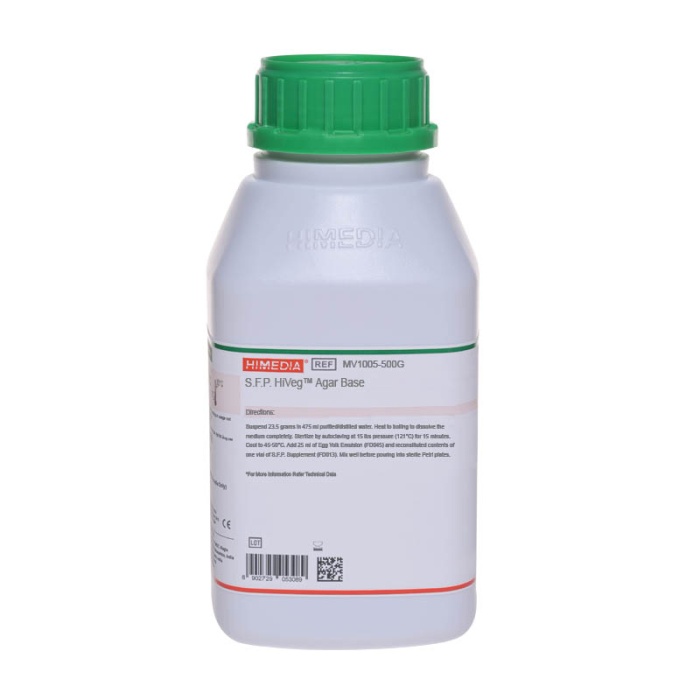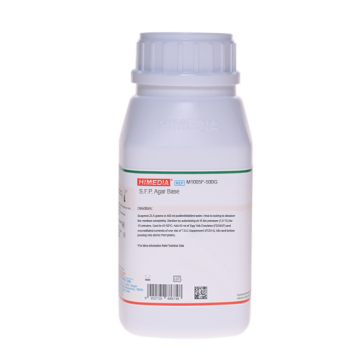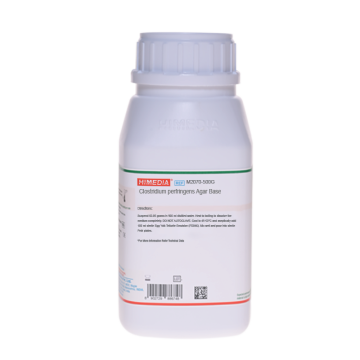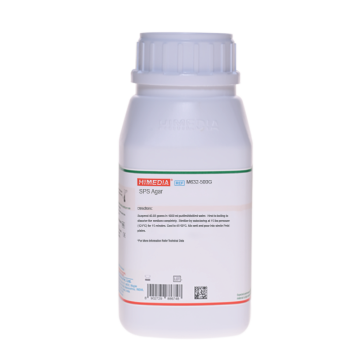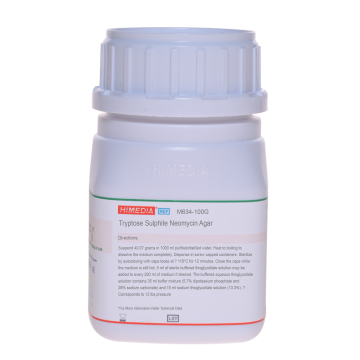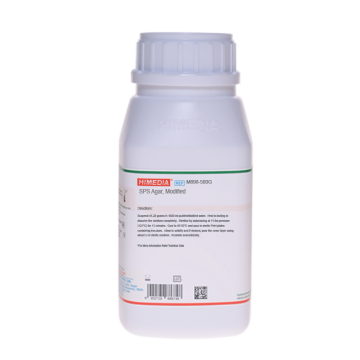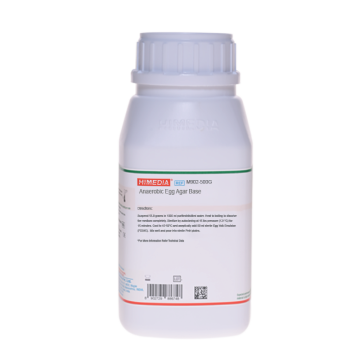 Your enquiry has been submitted
Your enquiry has been submitted
S.F.P. Agar Base
Intended Use
S.F.P. Agar Base with the addition of selective supplement and enrichment is used for the presumptive identification and enumeration of Clostridium perfringens in foods.
Composition
| Ingredients | Gms/Litre |
|---|---|
| Tryptose | 15.000 |
| Papaic digest of soyabean meal | 5.000 |
| Yeast extract | 5.000 |
| Sodium bisulphite | 1.000 |
| Ferric ammonium citrate | 1.000 |
| Agar | 20.000 |
Final pH (at 25°C): 7.6±0.2
**Formula adjusted, standardized to suit performance parameters
Directions
Suspend 23.5 grams in 475 ml distilled water. Heat to boiling to dissolve the medium completely. Sterilize by autoclaving at 15 lbs pressure (121°C) for 15 minutes. Cool to 50°C. Add 25 ml of Egg Yolk Emulsion (FD045) and reconstituted contents of 1 vial of S.F.P. Supplement (FD013). Mix well before pouring into sterile Petri plates.
Principle And Interpretation
Clostridium perfringens food poisoning is one of the common types of human food borne illness. C. perfringens is found in raw meats, poultry, dehydrated soups and sauces, raw vegetables and other foods and food ingredients, but occurrences of foodborne illness are usually associated with cooked meat or poultry products (2). Spores of some strains that may resist heat during cooking germinate and grow in foods that are not adequately refrigerated (3). A heat-labile enterotoxin produced only by sporulating cells (5) induces the major symptom of diarrhea in perfringens poisoning. The foods in which conditions are favorable for sporulation may contain enterotoxin. The food poisoning can be diagnosed using quantitative anaerobic cultures to test food and faeces. Enumerating the microorganism in food samples plays a role in the epidemiological investigation of outbreaks of foodborne illness (2).
Shahidi Ferguson Perfringens (S.F.P.) Agar Base is prepared according to the formulation of Shahidi and Ferguson (1). Lecithinase and sulphite reactions can be identified on this medium. The medium along with the egg yolk emulsion and the supplement containing kanamycin and polymyxin B as the selective agents give high degree of selectivity for C. perfringens .Tryptose, papaic digest of soyabean meal and yeast extract supply nitrogenous compounds, carbon, sulphur, vitamin B complex etc. necessary for the growth of Clostridia. Sodium bisulphite and ferric ammonium citrate are the indicators of sulphite reduction by C. perfringens , which thereby produces black colonies. Kanamycin and polymyxin B (FD013) used in the medium inhibit competitive bacteria and thus allowing a better recovery of vegetative cells and spores of C. perfringens than either polymyxin B or sulphadiazine alone (2). Some strains of C. perfringens may form an opaque zone around the colony due to their lecithinase activity. Lecithinase positive facultative anaerobes may grow on S.F.P. Agar making the plates completely opaque and thus may mask the egg yolk reaction of C. perfringens .
Organisms other than C. perfringens may produce black colonies. Therefore presumptive C. perfringens colonies need to be further confirmed by motility test, nitrate reduction and gelatin liquefaction.
For the isolation and enumeration of C. perfringens from foodstuffs, inoculate the surface of the medium with 0.1 ml of decimal dilutions of the specimen in Peptone Water (M028). Allow the media surface to dry for 5-10 minutes. Cover the surface with 10 ml of agar without egg yolk emulsion and solidify (4). Incubate at 37°C for 20-24 hours in anaerobic conditions. For presumptive count, select and count those colonies, which are larger black and surrounded by an opaque zone.
Quality Control
Appearance: Cream to yellow homogeneous free flowing powder
Gelling: Firm, comparable with 2.0% Agar gel.
Colour and Clarity of prepared medium: Basal medium yields amber coloured slightly opalescent gel. With addition of Egg Yolk Emulsion, yellow coloured opaque gel forms in Petri plates.
Reaction: Reaction of the medium (4.7gm in 95 ml distilled water) at 25°C. pH: 7.6±0.2
pH: 7.40-7.80
Cultural Response
M1005: Cultural characteristics observed after an incubation at 35-37°C for 40-48 hours under anaerobic condition with added Egg Yolk Emulsion (FD045) and S.F.P. Supplement (FD013).
| Organism | Inoculum (CFU) | Growth | Recovery | Colour of colony | Lecithinase |
|---|---|---|---|---|---|
| Clostridium perfringens ATCC 12924 | 50-100 | luxuriant | >=50% | black | positive reaction, opaque zone around colony |
| Escherichia coli ATCC 25922 | >=103 | inhibited | 0% | - | negative reaction |
Storage and Shelf Life
Store below 30°C in tightly closed container and the prepared medium at 2-8°C. Use before expiry date on the label.
References
- Shahidi S. A. and Ferguson A. R., 1971, Appl. Microbiol. 21:500.
- Downes F. P. and Ito K., (Eds.), 2001, Compendium of Methods for the Microbiological Examination of Foods, 4th Ed., APHA, Washington, D.C.
- Harmon S. M., Kautter D. A. and Peeler J. T., 1971, Appl. Microbiol., 21:922.
- ICMSF 1978, Microorganisms in food; Their Significance and Methods of Enumeration. University of Toronto Press.264-273.
- Duncan C. L., 1973, J. Bacteriol., 113:932.
| Product Name | S.F.P. Agar Base |
|---|---|
| SKU | M1005 |
| Product Type | Regular |
| Physical Form | Powder |
| Origin | Animal |
| Packaging type | HDPE |
| References | 1. Shahidi S. A. and Ferguson A. R., 1971, Appl. Microbiol. 21:500. |
| Customized Product Available | No |





